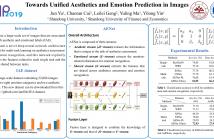- Image/Video Storage, Retrieval
- Image/Video Processing
- Image/Video Coding
- Image Scanning, Display, and Printing
- Image Formation

- Read more about ENHANCE FEATURE REPRESENTATION OF ELECTROENCEPHALOGRAM FOR SEIZURE DETECTION
- Log in to post comments
In the treatment of epilepsy with intracranial electroencephalogram(iEEG), the recognition accuracy is low, and it is
difficult to find the correlation between channels because of the large amount of channel numbers and time series data. In
order to solve these problems, we propose a novel EEG feature prepresentation method for seizure detection based on the
Log Mel-Filterbank energy feature. We propose to adapt the Mel-Filterbank energy to EEG features with logrithm transform
- Categories:
 57 Views
57 Views
- Read more about JOINT LEARNING OF SELF-REPRESENTATION AND INDICATOR FOR MULTI-VIEW IMAGE CLUSTERING
- Log in to post comments
- Categories:
 37 Views
37 Views
- Read more about Single-image rain removal via multi-scale cascading image generation
- Log in to post comments
A novel single-image rain removal method is proposed based on multi-scale cascading image generation (MSCG). In particular, the proposed method consists of an encoder extracting multi-scale features from images and a decoder generating de-rained images with a cascading mechanism. The encoder ensembles the convolution neural networks using the kernels with different sizes, and integrates their outputs across different scales.
- Categories:
 41 Views
41 Views
- Read more about Learning The Set Graphs: Image-Set Classification Using Sparse Graph Convolutional Networks
- Log in to post comments
- Categories:
 27 Views
27 Views
- Read more about VARIABLE-LENGTH QUANTIZATION STRATEGY FOR HASHING
- Log in to post comments
- Categories:
 18 Views
18 Views
- Read more about When Causal Intervention Meets Adversarial Examples and Image Masking for Deep Neural Networks
- 2 comments
- Log in to post comments
Discovering and exploiting the causality in deep neural networks (DNNs) are crucial challenges for understanding and reasoning causal effects (CE) on an explainable visual model. "Intervention" has been widely used for recognizing a causal relation ontologically. In this paper, we propose a causal inference framework for visual reasoning via do-calculus. To study the intervention effects on pixel-level features for causal reasoning, we introduce pixel-wise masking and adversarial perturbation.
- Categories:
 51 Views
51 Views
- Categories:
 72 Views
72 Views
- Read more about CNN-BASED LUMINANCE AND COLOR CORRECTION FOR ILL-EXPOSED IMAGES
- Log in to post comments
Image restoration and image enhancement are critical image processing tasks since good image quality is mandatory for many image applications. We are particularly interested in the restoration of ill-exposed images. These effects are caused by sensor limitation or optical arrangement. They prevent the details of the scene from being adequately represented in the captured image. We proposed a deep neural network model due to the number of uncontrolled variables that impact the acquisition.
PPT_ICIP.pdf
- Categories:
 58 Views
58 Views
- Read more about EMBEDDED CYCLEGAN FOR SHAPE-AGNOSTIC IMAGE-TO-IMAGE TRANSLATION
- Log in to post comments
- Categories:
 26 Views
26 Views